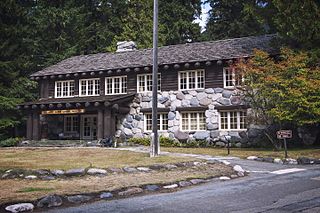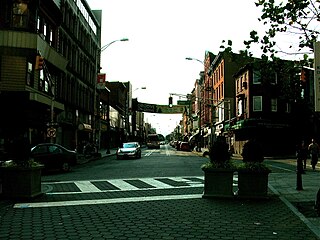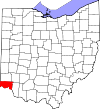Description and history
Mariemont is a village located about 10 miles (16 km) east of downtown Cincinnati in Hamilton County, on United States Route 50 (aka Wooster Pike), which serves as the principal route through the community. The village occupies an area on the north bank of the Little Miami River that is roughly rectangular with protrusions to the north, east and southwest. The bulk of the village is residential, with multifamily housing predominant north of Wooster Pike, and single-family housing to its south. Most of the housing is on winding lanes in a parklike setting; some of it is in a rectilinear grid pattern. Industry is restricted to the southwestern protrusion, known as Westover, which extends between Wooster Pike and a railroad right-of-way on the riverbank. Commercial and retail activity is mainly located on Wooster Pike, with a smaller area at Oak and Chestnut Streets. Architecturally, the village resembles an English country village, with large amounts of Tudor Revival architecture, and a stone English country church. [3]
The village has several large parks. Dogwood Park is on the west side of the village, which houses the memorial carillon, offering concerts on Sundays throughout the summer months. Miami Bluff Drive provides good views over the river, and Mariemont Gardens is an area in the floodplain below the bluff which was used historically as farmland when not flooded. Located on the embankment below the drive is the Madisonville site, a prehistoric Native American site that attracted early American settlers to the area. [3] The village square serves as the community center with red brick Tudor buildings, including the Mariemont Inn and historical Mariemont Barber Shop. Mariemont also has one of the few elected Town Criers remaining in North America.
Mariemont was the brainchild of Mary Emery, a philanthropist seeking to alleviate housing shortages and poor housing conditions after World War I. Working with Charles Livingood, she retained landscape architect John Nolen to draft a comprehensive plan for the village, in which the location and nature of a great deal of its infrastructure was specified. The plan was accepted in 1921, and development took place mostly over the following decade. The Mariemont Company, formed and managed by Emery and Livingood, oversaw the development until 1931, when it was formally dissolved and most of its tangible assets were turned over to the community. The company hired architects from major eastern cities to design buildings of all types in the village. [3]
In the decades following the village's creation, development has continued, although at a restrained pace. The village has grown by acquisition of land surrounding its original planned area, and portions of Nolen's design were either not fully implemented, or have undergone subsequent alteration that is not in keeping with the plan. These are generally small and the alterations are rarely intrusive. When the village was surveyed for National Historic Landmark designation in the early 2000s, the only areas of the village that were omitted from the landmarked area were the hospital and high school areas in the east, and small areas north of the historic bounds.the high school's design reflected some rather radical architectural and educational ideas not in keeping with the traditional architecture of the village. [3] The 1979 National Register nomination omitted slightly larger sections in the same area, as well as the entire Mariemont Gardens area, which is separated from the balance of the village by railroad tracks. [4]

Riverside is a suburban village in Cook County, Illinois, United States. A significant portion of the village is in the Riverside Landscape Architecture District, designated a National Historic Landmark in 1970. The population of the village was 9,298 at the 2020 census, up from 8,875 at the 2010 census. It is a suburb of Chicago, located roughly 9 miles (14 km) west of downtown Chicago and 2 miles (3 km) outside city limits.

Mariemont is a village in Hamilton County, Ohio, United States. It includes two overlapping historic districts, Village of Mariemont and Mariemont Historic District. Named for its founder, Mary Emery, Mariemont exhibits English architecture from Norman to classic Georgian style. Several parks exist in the village, including the Concourse on Miami Bluff Drive, and Dogwood Park that offers carillon concerts on Sundays throughout the summer months. The village square serves as the community center with red brick Tudor buildings, including the Mariemont Inn and Mariemont Barber Shop. Mariemont has one of the few elected town criers remaining in North America. In 2007, the Village of Mariemont was designated a National Historic Landmark. The population was 3,518 at the 2020 census.

Lookout Studio, known also as The Lookout, is a stone building located on the South Rim of the Grand Canyon, within Grand Canyon National Park in Arizona. It is part of the Grand Canyon Village Historic District, and is part of the Mary Jane Colter Buildings National Historic Landmark. It currently operates as a gift shop and observation station for visitors, with telescopes on its outdoor terrace. Lookout Studio was constructed by the Santa Fe Railway in 1914 and was established as a photography studio to compete with Kolb Studio. It is one of six buildings at the Grand Canyon that were designed by architect Mary Colter, along with Bright Angel Lodge, Hermit's Rest, Hopi House, Phantom Ranch, and Desert View Watchtower. Lookout Studio employs her signature rustic style of using jagged native rocks to imitate indigenous structures of the region and to blend in with the environment.

The Arthur H. Compton House is a historic house at 5637 South Woodlawn Avenue in Chicago, Illinois. Built in 1905 and designed by architects Holabird & Roche, it was the residence of physicist Arthur Compton (1892–1962) from 1928 until 1945. Compton discovered the Compton Effect in 1923, proving that light has both a particle and a wave aspect. Compton received the Nobel Prize in Physics in 1927 for this discovery. His house was designated a National Historic Landmark in 1976.

The Wooster Square Historic District encompasses much of the Wooster Square neighborhood of New Haven, Connecticut. Centered on a rectangular park named in honor of General David Wooster, the area was developed as a residential neighborhood beginning in the 1820s, and was by the 1840s a desirable area to live, with many high-quality Greek Revival homes. In the 1950s the area was the subject of a major community-led preservation effort that drew national attention. The district was listed on the National Register of Historic Places in 1971.

The Madisonville site is a prehistoric archaeological site near Mariemont, Ohio, United States. It was listed on the National Register of Historic Places on October 16, 1974 as the "Mariemont Embankment and Village Site".

Grand Canyon Village Historic District comprises the historic center of Grand Canyon Village, on the South Rim of the Grand Canyon in Grand Canyon National Park, Arizona. The district includes numerous landmark park structures, many of which are National Historic Landmarks themselves, or are listed on the National Register of Historic Places. The town design as a whole is also significant for its attention to integration with the Grand Canyon landscape, its incorporation of National Park Service Rustic design elements, and for the idiosyncratic design of park concessioner structures such as the El Tovar Hotel.

The Riverside Historic District, also known as Riverside Landscape Architecture District, encompasses what is arguably one of the first planned suburbs in the United States. The district encompasses the majority of the village of Riverside, Illinois, a suburb just west of Chicago. It was planned and designed by Calvert Vaux and Frederick Law Olmsted, and features a number of architecturally distinguished buildings.

Village Green, originally named Baldwin Hills Village, is a neighborhood at the foot of Baldwin Hills, within the city of Los Angeles, California. Village Green consists of a large condominium complex that is both a Los Angeles Historic-Cultural Monument and a National Historic Landmark. Designed in the late 1930s and built out by 1942, it is one of the oldest planned communities of its type in the nation. Village Green was named by The American Institute of Architects as one of the 100 most important architectural achievements in U.S. history.

The Longmire Buildings in Mount Rainier National Park comprise the park's former administrative headquarters, and are among the most prominent examples of the National Park Service Rustic style in the national park system. They comprise the Longmire Community Building of 1927, the Administration Building of 1928, and the Longmire Service Station of 1929. Together, these structures were designated National Historic Landmarks on May 28, 1987. The administration and community buildings were designed by National Park Service staff under the direction of Thomas Chalmers Vint.

The Main Street Historic District in Danbury, Connecticut, United States, is the oldest section of that city, at its geographical center. It has long been the city's commercial core and downtown. Its 132 buildings, 97 of which are considered contributing properties, include government buildings, churches, commercial establishments and residences, all in a variety of architectural styles from the late 18th century to the early 20th. It is the only major industrial downtown of its size in Connecticut not to have developed around either port facilities or a water power site.

Harsimus is a neighborhood within Downtown Jersey City, Hudson County, in the U.S. state of New Jersey. The neighborhood stretches from the Harsimus Stem Embankment on the north to Christopher Columbus Drive on the south between Coles Street and Grove Street or more broadly, to Marin Boulevard. It borders the neighborhoods of Hamilton Park to the north, Van Vorst Park to the south, the Village to the west, and the Powerhouse Arts District to the east. Newark Avenue has traditionally been its main street. The name is from the Lenape, used by the Hackensack Indians who inhabited the region and could be translated as Crow’s Marsh. From many years, the neighborhood was part of the "Horseshoe", a political delineation created by its position between the converging rail lines and political gerrymandering.
Worthland is an unincorporated community in New Castle County, Delaware, United States. Worthland is located northwest of U.S. Route 13 and northeast of Interstate 495 to the northeast of Claymont. It was originally developed by Worth Steel Corporation as a community for its workforce.

Frederick W. Garber was an American architect in Cincinnati, Ohio and the principal architect in the Garber & Woodward firm with Clifford B. Woodward (1880–1932). The firm operated from 1904 until it was dissolved in 1933 Their work has been described as in the Beaux-Arts tradition and included buildings on the University of Cincinnati campuses, schools, hospitals, commercial buildings, "fine residences" and public housing.

The Baumann family was a family of American architects who practiced in Knoxville, Tennessee, and the surrounding region, in the late 19th and early 20th centuries. It included Joseph F. Baumann (1844–1920), his brother, Albert B. Baumann, Sr. (1861–1942), and Albert's son, Albert B. Baumann, Jr. (1897–1952). Buildings designed by the Baumanns include the Mall Building (1875), the Church of the Immaculate Conception (1886), Minvilla (1913), the Andrew Johnson Building (1930), and the Knoxville Post Office (1934).

Marcy Village Apartments is a historic community located in Indianapolis, Indiana, United States. Built in 1939, the 25-acre (10 ha), 19-building apartment community compose a historic district that was listed on the National Register of Historic Places on March 24, 2004. Ground for the development was broken the week of March 20, 1939, and work was started on a full-time basis with Everett A. Carson of Indianapolis as the builder. Architects, Granger & Bollenbacher of Chicago, created the Colonial Revival apartment community for owners at the time, Marcy Realty Corporation.
Architects of the National Park Service are the architects and landscape architects who were employed by the National Park Service (NPS) starting in 1918 to design buildings, structures, roads, trails and other features in the United States National Parks. Many of their works are listed on the National Register of Historic Places, and a number have also been designated as National Historic Landmarks.

Edmund Beaman Gilchrist was an American architect, best remembered for his English-Cotswold and French-Norman suburban houses.

The Arlington Village Historic District is a national historic district located at Arlington County, Virginia. It contains 657 contributing buildings in a residential neighborhood in South Arlington. The area was constructed in 1939, and is a planned garden apartment community that incorporates recreational areas, open spaces, a swimming pool and courtyards within five superblocks. It also includes a shopping center consisting of six stores. The garden apartments are presented as two-story, brick rowhouses with Colonial Revival detailing. There are three building types distinguished by the roof form: flat, gambrel, or gable. Arlington Village was the first large-scale rental project in Arlington County and the first Federal Housing Administration-insured garden apartment development. It was listed on the National Register of Historic Places in 2008.
The Woman's Art Club Cultural Center, also known as "The Barn", is a community arts and culture center located in Mariemont, Ohio and operated by the Woman's Art Club of Cincinnati Foundation.




















